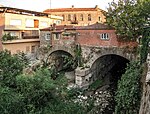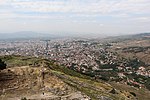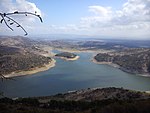Bergama

Bergama is a municipality and district of İzmir Province, Turkey. Its area is 1,544 km2, and its population is 105,754 (2022). By excluding İzmir's metropolitan area, it is one of the prominent districts of the province in terms of population and is largely urbanized at the rate of 53.6%. Bergama center is situated at a distance of 118 km (73 mi) to the north from the point of departure of the traditional center of İzmir (Konak Square in Konak, İzmir) and lies at a distance of 27 km (17 mi) inland from the nearest seacoast at the town of Dikili to its west. Bergama district area neighbors the areas of three districts of Balıkesir Province to its north, namely Ayvalık, Burhaniye and İvrindi, İzmir Province district of Kınık and Manisa Province district of Soma to its east, while to the south it is bordered by Yunusemre district of Manisa Province and two other İzmir Province districts along the coast that are Aliağa and Dikili from its south towards its west. The district area's physical features are determined by the alluvial plain of Bakırçay River.
Excerpt from the Wikipedia article Bergama (License: CC BY-SA 3.0, Authors, Images).Bergama
1. Göçmen Sokak,
Geographical coordinates (GPS) Address Nearby Places Show on map
Geographical coordinates (GPS)
| Latitude | Longitude |
|---|---|
| N 39.116666666667 ° | E 27.183333333333 ° |
Address
1. Göçmen Sokak
1. Göçmen Sokak
35700 , Turabey Mahallesi
Turkey
Open on Google Maps








